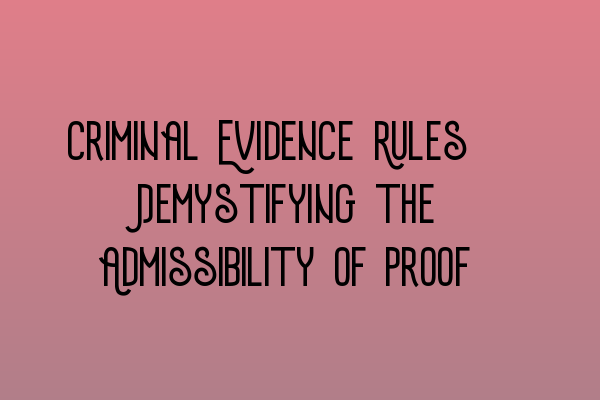Criminal Evidence Rules: Demystifying the Admissibility of Proof
Welcome to the SQE Criminal Law & Practice Law UK blog! In today’s post, we will be shedding light on the complex world of criminal evidence rules and demystifying the admissibility of proof. Understanding these rules is essential for any aspiring criminal lawyer, as they form the basis of presenting and evaluating evidence in a court of law.
The Fundamental Principles of Admissibility
Before delving into the specifics, it is important to grasp the fundamental principles governing the admissibility of evidence. The court’s primary concern is to ensure a fair trial, and hence, only relevant, reliable, and credible evidence is admissible.
Relevance is key when it comes to admissibility. Evidence must be directly connected to the issue at hand and must assist the court in reaching a just verdict. The court will carefully evaluate the probative value of the evidence, weighing its significance against any potential prejudicial effects.
Another crucial factor is reliability. The court needs to be confident that the evidence, whether it is testimonial or physical, is trustworthy and accurate. This is especially important in criminal cases, where the stakes are high and the accused’s liberty is at risk.
Categories of Admissible Evidence
Now that we understand the underlying principles, let’s explore the different categories of admissible evidence:
- Oral Testimony: Witness statements and expert opinions fall under this category. Witnesses are examined and cross-examined, allowing the court to evaluate their credibility and the reliability of their testimony.
- Documentary Evidence: Written documents, such as contracts, medical records, or financial statements, can be admitted as evidence. The authenticity and relevance of these documents are crucial in determining their admissibility.
- Real Evidence: Physical objects that are directly linked to the case, such as weapons, drugs, or fingerprints, can be presented as evidence. The chain of custody and preservation of the evidence are important considerations.
- Circumstantial Evidence: This type of evidence relies on inference and implies a fact without directly proving it. Circumstantial evidence can be highly persuasive if it establishes a strong connection to the issue.
- Hearsay: Hearsay evidence is an out-of-court statement offered for the truth of the matter asserted. It is generally not admissible, but there are exceptions based on the circumstances and the purpose for which it is being presented.
Challenges to Admissibility
Despite the general principles and categories, there are various challenges to the admissibility of evidence. These challenges can arise from violations of procedural rules, improper conduct during collection or handling of evidence, or breaches of the accused’s rights.
It is crucial for criminal lawyers to be well-versed in these challenges and to employ appropriate legal strategies to counter them. Failing to do so may result in the exclusion of crucial evidence, which could significantly impact the outcome of a case.
Conclusion
The admissibility of proof is a complex and nuanced area of criminal law. Our aim with this blog post was to provide a brief overview and demystify the key concepts surrounding evidence rules. It is essential for aspiring criminal lawyers to have a solid understanding of these rules to effectively represent their clients and ensure a fair trial.
If you found this article informative, you may also be interested in these related articles:
- SQE 1 Practice Exam Questions
- SQE 1 Practice Mocks FLK1 FLK2
- SQE 2 Preparation Courses
- SQE 1 Preparation Courses
- SRA SQE Exam Dates
Thank you for reading our blog post! Feel free to contact SQE Criminal Law & Practice Law UK for any further inquiries or legal assistance.
